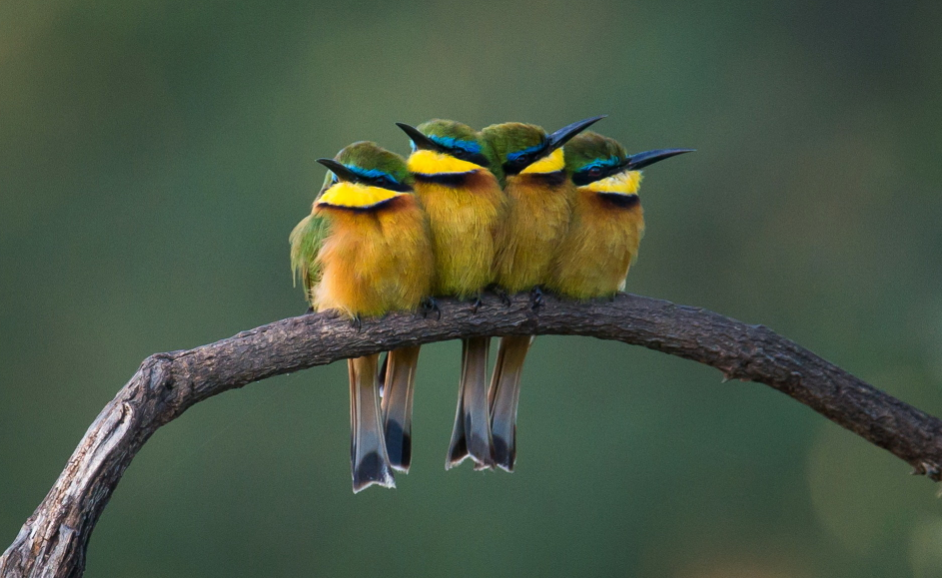
Characteristics and behaviours of Bee-eater Bird that make them fascinating creatures
Bee-eaters are an amazing bird species that stand out for their vibrant colours and distinctive feeding habits. The Meropidae family includes these birds, which are found in Europe, Africa, Asia, and Australia. Long, pointed wings, slender bodies, and a characteristically extended mouth make bee-eaters easily identifiable.
Hunting techniques of Bee-eater Bird, such as aerial acrobatics and perching strategies
One of the most interesting things about bee-eaters is how they feed. The name of the bird suggests that it mostly devours bees and other flying insects. Their technique for catching their prey is a little different; they perch on a branch or wire and then jump far into the air to catch insects midair. Once they have captured their prey, bee-eaters return to their perch to remove the stingers before consuming the food.
Colour patterns and Vocalisations that differentiate various species of Bee-eater Bird
Bee-eaters are distinguished by their stunning plumage, which varies according to the species. In bee-eaters, bright and brilliant colours like green, blue, yellow, and red are typical. These colours not only seem good, but they also make them blend in with their environment. Additionally, bee-eaters have unique vocalisations and cries that they use in communication and courting. Especially well-known are their elaborate courtship displays, when the birds astonish potential mates with gifts and flying manoeuvres. All things considered, bee-eaters are fascinating birds that exhibit distinctive traits in addition to beauty.
Fascinating facts about Bee-eater Bird
The bee-eater family of birds is distinguished by its vivid colours, elegant flying patterns, and distinctive eating preferences. These birds are distributed across the globe, particularly in Africa, Asia, and Europe. They are members of the Meropidae family. We will examine some amazing information on bee-eater birds in this piece.
Description of the vibrant colours of Bee-eater Bird
Bee-eaters are well-known for their exquisite and vivid plumage. The majority of species are multicoloured, with hues ranging from green to blue to yellow to red. They complement their surroundings and are aesthetically pleasing due to their colours. The European bee-eater (Merops apiaster), which has a blue-green crown, a yellow neck, and a mostly golden-brown back, is among the most remarkable forms. They are indeed a sight to see due to the mix of these colours.

Bee-eater Bird primarily feed on bees and other insects
Bee-eaters, as the name implies, mostly consume bees and other flying insects. To capture and devour their prey, they have evolved special characteristics. Eliminating bee stings before ingestion is among the most remarkable strategies used by bee-eaters.
Hunting techniques and feeding behaviour of Bee-eater Bird
Bee-eaters sit on a branch or wire and search the air for flying insects while they are hunting. They launch themselves into nimble flight as soon as they detect their meal, snatching the insects with their keen beaks midair. After that, they return to their perches and expertly swat the prey against a hard surface many times to remove the stingers.
Migration routes and destinations of Bee-eater Bird
The amazing migratory habits of bee-eaters are well known. Numerous species migrate across great distances, covering thousands of km to arrive at their breeding or wintering sites.
Migration Pattern: country and place of Bee-eater Bird
The European bee-eater, for example, travels an amazing distance from its breeding grounds in Europe to its wintering sites in sub-Saharan Africa. The birds use a variety of environmental signals to navigate across many thousand kilometres throughout their trip.
Factors influencing migration behaviour of Bee-eater Bird
Bee-eaters gather in big groups during migration, and their coordinated flying patterns are a captivating sight. The migration is a breathtakingly beautiful natural event, with groups of hundreds or perhaps thousands of birds.
Roles of different group members in cooperative breeding
A number of individuals help raise the young in the cooperative breeding behaviour seen by some bee-eater species. A second adult, referred to as a helper, is present in this cooperative breeding system and helps the breeding couple with different chores.
Human impact on populations of Bee-eater Bird
The workers contribute to the construction of the nest, egg incubation, and chick feeding. The helpers’ cooperative behaviour guarantees the survival and well-being of the offspring by contributing to the general upkeep and safeguarding of the nest.
Types of cavities, such as abandoned burrows and tree hollows, preferred by Bee-eater Bird
Since bee-eaters are cavity nesters, their nests are built inside of pre-existing tunnels or holes. As nesting locations, they often use riverbeds, cliffs, and sandy banks. Their feet and beaks are used to dig the nesting burrows, which results in a tube that leads to the nesting chamber.
Cavity nesting provides a safe environment for raising their young
The female bee-eater deposits her eggs, typically two to six per clutch, as soon as the burrow is ready. The eggs hatch after a few weeks of incubation, with the male and female taking turns hatching them. When the chicks are ready to fledge, they are given a diet consisting only of regurgitated insects.
Bee-eater Bird feeding habits and nesting behaviour
With their vivid plumage, peculiar eating habits, spectacular migrations, cooperative breeding behaviour, and distinctive nesting behaviour, bee-eaters are absolutely amazing birds. These birds are proof of the richness and splendour of the avian kingdom.
Bee-eater Bird ecological significance and their role in maintaining a healthy environment
Awe-inspiring aerial acrobatics and impressive hunting prowess are on display when bee-eaters are seen in their native environments. Bee-eaters never cease to enthral bird watchers and environment lovers with their remarkable colours and intriguing behaviours.


